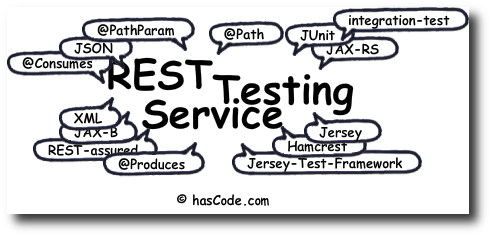Articles Tagged ‘rest’
Friday, August 31st, 2018
The OpenAPI and Swagger API description format are becoming important standards to specify API contracts for RESTful web services and the Microservices trend pushes the need for such contracts even further.
Therefore arises the need for software architects, testers and developers to write tests to verify if an exposed API follows such a specified contract.
In the following tutorial I will demonstrate a setup with Java, Maven, JUnit and the designated contract-testing-library, assertj-swagger that verifies the validity of such a contract exposed by a Spring Boot application against a local stored definition.
(more…)
Tags: Api, contract, contract-driven, failsafe, json, junit, maven, openapi, rest, schema, spring-boot, springfox, surefire, swagger, testing, yaml
Posted in Java, Web Services, testing | No Comments »
Thursday, April 6th, 2017
There is a new testing framework out there called Karate that is build on top of the popular Cucumber framework.
Karate makes it easy to script interactions with out web-services under test and verify the results. In addition it offers us a lot of useful features like parallelization, script/feature re-use, data-tables, JsonPath and XPath support, gherkin syntax, switchable staging-configurations and many others.
In the following tutorial we’ll be writing different scenarios and features for a real-world RESTful web-service to demonstrate some of its features.
(more…)
Tags: attd, bdd, cucumber, feature, http, Java, javascript, json, junit, karate, rest, restful, scenario, soap, tdd, testing, xml
Posted in Java, Web Services, testing | 4 Comments »
Sunday, September 18th, 2016
When it comes to writing microservices in Java, plenty of tools and frameworks exist. In the following tutorial, I’d like to demonstrate another minimalistic framework called Bootique by implementing a simple microservice exposing its functions either as a RESTful web-service or as a runnable command executed using the command line. (more…)
Tags: bootique, cli, command, di, guice, http, jax-rs, jaxrs, jetty, maven, microservice, microservices, rest, yaml
Posted in Java | No Comments »
Tuesday, January 5th, 2016
When writing tests for our software components sometimes we need to mock external services based on the HTTP protocol, might it be a RESTful web-service, an XML-RPC call or a simple GET request to some web-server.
In the following short tutorial I’d like to demonstrate how to create a mock HTTP server for testing and how to bootstrap and bind it to the life-cycle of a classical build-management tool like Maven.
(more…)
Tags: fake, http, https, integrationtest, junit, maven, mock, mockserver, rest, server, stub, test, verify
Posted in Java, testing | 3 Comments »
Thursday, October 22nd, 2015
For us developers there plenty of libraries exist helping us in deriving and generating clients for existing RESTful web-services and I have already covered some of the in this blog (e.g. the JAX-RS Client API). Nevertheless, I’d like to share my experience with another interesting lightweight library here: Netflix Feign.
Feign offers a nice fluent-builder API, a rich integration for common libraries and APIs like JAX-RS, Jackson, GSON, SAX, JAX-B, OkHttp, Ribbon, Hystrix, SLF4J and more and last bot not least, it is setup easy and the service contracts are specified using interfaces and annotations.
In the following tutorial I’d like to demonstrate how to derive a service binding from a simple, JAX-RS based RESTful web-service, how to create the service adapter using the integrated builder and at last, performing CRUD operations.
(more…)
Tags: client, feign, gson, jackson, jax-b, jax-rs, jaxb, jaxrs, json, netflix, rest, restful, retrofit, sax, webservice, webservices
Posted in Java, Web Services | 1 Comment »
Tuesday, August 18th, 2015
HipChat is Atlassian’s alternative to Slack and its solution to team collaboration chats. Atlassian Connect offers developer tools to bootstrap applications, connect to Atlassian’s cloud products with easy and in combination with HipChat’s REST APIs allows us to write integrations for such a chat server in no time.
In the following tutorial I’d like to show how to write an integration within a few steps using Atlassian Connect, Node.js and Express and how to connect the integration to a HipChat server.
Finally on the one hand I’m going to explain how to speed up local development with ngrok, an in-memory database and nodemon for automatic application restarts and on the other hand I’m going to demonstrate how to configure the application for production, running with a Redis key-value store on Heroku.
(more…)
Tags: Atlassian, atlassian-connect, chat, database, db, express, heroku, hipchat, inmemory, integration, javascript, js, jugglingdb, ngrok, node, nodejs, nodemon, nosql, npm, oath, oauth2, redis, rest, slack, staging, webhook
Posted in Development, Javascript | No Comments »
Wednesday, July 1st, 2015
Spring Boot allows us to create RESTful web-services with ease, Swagger specifies a format to describe the capabilities and operations of these services and with Swagger UI it is possible to explore our REST API with a nice graphical user interface in our browser.
Springfox is a project that aims at creating automated JSON API documentation for API’s built with Spring and is used in the following tutorial to integrate Swagger into a sample application.
(more…)
Tags: Api, documentation, gradle, json, rest, restful, schema, spring, spring-boot, springfox, swagger, swagger-ui, webservices
Posted in Java, Web Services | 11 Comments »
Tuesday, June 16th, 2015
A variety of different tools exists to help us analyze RESTful web-services and create documentations for their APIs in different formats.
In the following tutorial I’d like to demonstrate how to document an existing JAX-RS web-service in multiple formats like Swagger, AsciiDoc or Plain Text using Maven, the JAX-RS Analyzer and the JAX-RS Analyzer Maven Plugin.
The JAX-RS Analyzer gathers its information not only by reflection like most other tools but also by bytecode analysis and therefore does not require us to add special annotations for documentation to our code.
(more…)
Tags: Api, asciidoc, documentation, jax-rs, jaxrs, json, maven, rest, restful, swagger, webservice, ws
Posted in Enterprise, Java, Web Services | No Comments »
Sunday, December 21st, 2014
Especially when it comes to testing, setting up a decent environment for a secured Java EE web application isn’t always an easy thing to do.
In the following tutorial I’d like to demonstrate how to create a secured web application using form-based authentication and a JDBC realm to fetch users and roles and how to run the application in an embedded container for testing and development.
Additionally I’d like to show how to write and run integration tests to verify the security setup using a setup of Maven, Embedded GlassFish, Arquillian, jUnit and rest-assured.
(more…)
Tags: arquillian, authentication, eclipselink, glassfish, h2, it, javaee, jdbc, jdbcrealm, junit, maven, rest, rest-assured, security, testing
Posted in Enterprise, Java | 1 Comment »
Sunday, September 28th, 2014
Because a lot of my current projects are using JAX-RS in different versions I’d like to write down and share some frequently used snippets for implementing RESTful web-services with the JAX-RS specification here.
(more…)
Tags: jackson, javaee, jax-rs, jaxrs, jersey, json, rest, Snippet, xml
Posted in Java, Web Services, XML | No Comments »
Thursday, July 31st, 2014
I have written about other database migration frameworks before but in this article I’d like to cover the Liquibase framework in combination with WildFly as Java EE 7 compatible application server.
In the following tutorial, we’re going to write a full Java EE 7 book store application with a few steps and with Liquibase on board to create the database structure and insert example data into the database.
Thanks to the WildFly Maven Plug-in we even do not need to download and configure the application server but let Maven and the plug-in do the work for us.
(more…)
Tags: application server, as, curl, db, dbmigrate, ejb, entitymanager, h2, javaee, javaee7, jax-rs, jaxrs, jee, jpa, json, liquibase, migration, persistence, rdbms, rest, wildfly
Posted in Enterprise, Java, Web, Web Services | 3 Comments »
Monday, May 26th, 2014
Using dependency injection and aspect-oriented mechanisms like interceptors allow us to separate cross-cutting-concerns in our Java enterprise application, to control global aspects of our application and to avoid boilerplate code.
In the following short tutorial we’re going to create an aspect-oriented logger to protocol the initiating user, class and method called and the parameters passed to the method and finally we’re adding this interceptor to a sample RESTful web-service by adding a simple annotation.
(more…)
Tags: aop, authentication, basic-auth, cdi, di, ejb, glassfish, interceptor, javaee, javaee7, jax-rs, jaxrs, jee, logging, rest
Posted in Enterprise, Java | 2 Comments »
Monday, December 30th, 2013
JAX-RS 2.0 aka JSR 339 not also specifies the API to build up a RESTful webservice but also enhances the client side API to easen up the process of writing a client for a REST service.
In the following tutorial we’re building up a client for a ready-to-play REST service and explore the different new options e.g. how to handle requests in a synchronous or asynchronous way, how to add callback handlers for a request, how to specify invocation targets to build up requests for a later execution or how to filter the client-server communication using client request filters and client response filters.
(more…)
Tags: async, asynchronous, filter, glassfish, jackson, jax-rs, jaxrs, jersey, jsr-339, jsr339, rest, server, web, webservice
Posted in Java, Web Services | 13 Comments »
Sunday, October 23rd, 2011
 There are many frameworks out there to facilitate testing RESTful webservices but there is one framework I’d like to acquaint you with my favourite framework named REST-assured.
There are many frameworks out there to facilitate testing RESTful webservices but there is one framework I’d like to acquaint you with my favourite framework named REST-assured.
REST-assured offers a bunch of nice features like a DSL-like syntax, XPath-Validation, Specification Reuse, easy file uploads and those features we’re going to explore in the following article.
With a few lines of code and Jersey I have written a RESTful web service that allows us to explore the features of the REST-assured framework and to run tests against this service.
(more…)
Tags: groovy, jax-rs, jaxb, jaxrs, jersey, rest, rest-assured, tomcat, webservice, ws
Posted in Java, Web Services | 113 Comments »
Monday, September 5th, 2011
 Today we’re going to take a look at two specific frameworks that enables you to efficiently test your REST-ful services: On the one side there is the framework REST-assured that offers a nice DSL-like syntax to create well readable tests – on the other side there is the Jersey-Test-Framework that offers a nice execution environment and is built upon the JAX-RS reference implementation, Jersey.
Today we’re going to take a look at two specific frameworks that enables you to efficiently test your REST-ful services: On the one side there is the framework REST-assured that offers a nice DSL-like syntax to create well readable tests – on the other side there is the Jersey-Test-Framework that offers a nice execution environment and is built upon the JAX-RS reference implementation, Jersey.
In the following tutorial we’re going to create a simple REST service first and then implement integration tests for this service using both frameworks.
The title of this article might be misleading due to the fact that I am not going to compare both frameworks to choose a winner, just showing the different approach ..
(more…)
Tags: hamcrest, integrationtest, jax-b, jax-rs, jaxb, jaxrs, jersey, junit, rest, rest-assured, restful, service, test
Posted in Java, Web Services | 30 Comments »
Thursday, November 25th, 2010
Often in a developer’s life there is a REST service to deal with and nowadays one wants a fast and clean solution to create a client for such a service.
The following tutorial shows a quick approach using JAX-RS with its reference implementation, Jersey in combination with JAX-B for annotation driven marshalling between XML or JSON structures and our Java-Beans.
(more…)
Tags: jax-b, jax-rs, jaxrs, jersey, jsr-311, marshalling, maven, rest, tutorial, webservice
Posted in Java, Web Services | 9 Comments »

